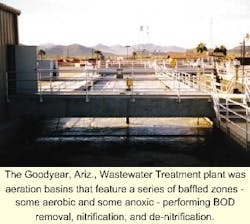Submersible Air Flow Meter Solves Control Problem
By Tom Jenkins
The Goodyear, Ariz., Wastewater Treatment Plant uses an automated dissolved oxygen (DO) and blower control system to maintain aeration levels in its biological treatment basins. An important part of the system is the control of air flow to individual zones within the basins.
Unfortunately, the accuracy of the original air flow measurement equipment was poor due to the air piping configuration. Satisfactory operation of automatic DO control was impossible until a new submersible air flow transmitter, the Snorkel, replaced the original units and provided accurate air flow measurements.
Goodyear's integrated DO and blower control system was installed in 1995 as part of a major plant upgrade. The system was designed and built by ESCOR - Energy Strategies Corporation - of Milwaukee, WI. The aeration basins are a series of baffled zones - some aerobic and some anoxic - performing BOD removal, nitrification, and de-nitrification. Aerobic digesters are incorporated into the basins as part of the air flow control.
In order to control the process performance of the system it was necessary to provide accurate air flow to maintain DO levels in the aerobic zones. Maintaining set air flows to the anoxic zones to maintain mixing at reduced DO readings is critical for satisfactory nutrient removal.
The ESCOR system minimizes the energy used by the multi-stage centrifugal aeration blowers. Three 150 hp blowers discharge into a common header. Total air flow to the aeration system is controlled by modulating inlet valves on each blower.
Each aeration zone and digester is equipped with a motor operated butterfly valve (BFV) and air flow transmitter to control air flow between individual zones.
It is widely recognized that accurate flow measurement requires straight, unobstructed pipe for a minimum of 10 diameters upstream and five diameters downstream of the flow measurement device. This establishes a uniform and symmetrical velocity profile across the pipe. Unfortunately, physical constraints and piping cost frequently force compromises in the piping layout that prevent location of the flow transmitters in a proper length of straight pipe.
The Goodyear air distribution piping is an example of this. The air headers run between two sets of aeration zones. The air for each zone is tapped from a cross fitting in the air main. A short spool piece passes through the basin wall, followed by the BFV and a 90 degree elbow down into the mixed liquor. The total straight pipe available is less than five diameters for most basins. To keep the air flow probes a reasonable distance above the mixed liquor, they were placed immediately down-stream of the 90 degree elbows.
The design engineer for the plant was aware that this arrangement would not produce accurate air flow measurement. However, it was assumed that the flow signals would be sufficiently stable and repeatable for the ESCOR system to control air flow rates with the accuracy needed for process performance.
That assumption proved to be incorrect. The air flow signals were very erratic. Because of the turbulence and non-uniform velocity profile produced by the BFV and elbow, the correlation between actual air flow and the transmitter signal was not uniform throughout the required flow range. In some cases the distorted flow profile caused the meters to indicate an increase in air flow as the BFV was throttled closed. This made it impossible to control the air flow to most zones with sufficient accuracy to maintain set DO and achieve consistent nutrient removal.
The Goodyear air piping does have sufficient straight pipe for accurate air flow measurement, but it's in the vertical drop pipe from the header to the diffuser grids. The optimum point of insertion is below the surface of the mixed liquor. Ordinary air flow transmitters are not suitable for installation in this location.
To solve the air flow problem, ESCOR designed a submersible air flow transmitter, the Snorkel. Developed in conjunction with Eldridge Products Inc., the Snorkel includes a stainless steel probe for submerged installation in the drop pipe and a NEMA 4X transmitter enclosure for installation on the hand rail. The interconnection wiring, 25 feet long, is double sealed and potted for resistance to moisture and corrosion. Non-metallic saddle tees and fittings were used to tap the drop pipe and install the probe.
Installation was accomplished in a matter of hours by plant staff. First, the aeration basins were partially drained. The saddle tees were clamped on after hand tools were used to drill the drop pipe. The air flow probes were inserted to the point of average velocity.
The double insulated wiring between the probe and the transmitter was fastened to the handrail and connected to the transmitter. The microprocessor based transmitter was set for the actual pipe cross-sectional area and the required flow range. New 24 vDC power supplies were provided and the existing 4-20 mA signal wiring was used to connect the flow transmitters to the control system. The display and transmitter signal were set to read directly in SCFM.
Conclusion
The new flow meters were a complete success. The readings were stable and accurate throughout the range of BFV travel. The control system was able to provide the required precision for air flow control in the aeration basins.
The problem resulting from the piping arrangement at the Goodyear facility is common. Because of restrictions on piping layout and tankage it is not always possible to locate conventional air flow measurement devices to obtain accurate flow readings. Since the Snorkel can be installed below the mixed liquor level in aeration basins and digester drop pipes, it can use the straight pipe available at the diffuser drops in most aeration basins. The result is accurate and repeatable measurement of the air flow rate in spite of compromised piping arrangements.
About the Author:
Thomas E. Jenkins, P.E., is Vice President of ESCOR (Energy Strategies Corporation). ESCOR provides automated process controls for the wastewater treatment industry - with special emphasis on aeration and blower controls.



